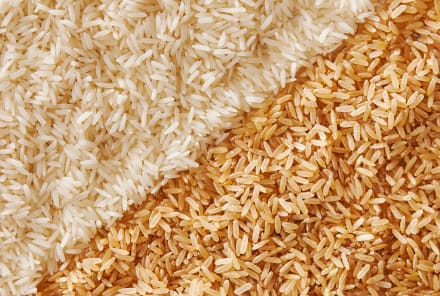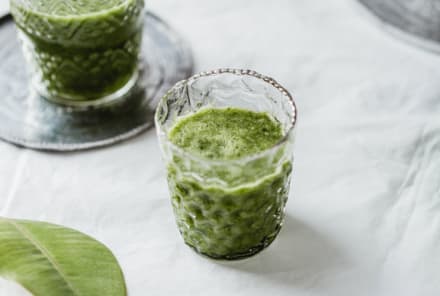Advertisement
15 Foods High In Leucine (Plant & Animal) — Plus A Sample Meal Plan


Leucine is an essential amino acid that plays a crucial role in muscle protein synthesis (MPS), making it a vital nutrient for athletes, bodybuilders, and weekend warriors alike. But what foods are high in leucine, and how much of it do you need to consume? Here, we'll explore the answers to these questions and more, including the benefits of leucine, the risks of deficiency, and the top leucine-rich foods.
Amino acid overview
Amino acids are the building blocks of protein. There are 20 amino acids1, and they're categorized into two groups: essential and nonessential.
Essential amino acids, including the branched-chain amino acids (BCAAs)—leucine, isoleucine, and valine—aren't produced by the body in sufficient quantities and must be obtained through diet. Conversely, nonessential amino acids can be synthesized by the body.
Essential amino acids are involved in the production of proteins2, which are essential nutrients for optimal health and several bodily functions. Protein synthesis is the process by which the body builds and repairs tissues3, including muscles, organs, and cells. Additionally, protein plays a vital role in maintaining and building muscle mass4 in response to exercise. All 20 amino acids are required5 to support this process when protein synthesis is activated.
BCAAs have garnered special attention in the fitness industry due to their role in MPS5 and post-exercise recovery6. And leucine is one BCAA that's particularly important for enhancing muscle growth and repair.
"Leucine is one of the main triggers of the mTROC1 signaling cascade, which is an important regulator of muscle protein synthesis (MPS)," explains David Church, Ph.D., an assistant professor at the University of Arkansas for Medical Sciences. "However, increases in mTORC1 signaling do not always equate to increased MPS or strength and mass gains. [That's because] leucine on its own doesn't increase in MPS."
Summary
What is leucine and why is it important?
Leucine is a vital amino acid with remarkable importance for MPS and overall health. Don Layman, Ph.D., a leading amino acid researcher and professor at the University of Illinois at Urbana-Champaign, tells mindbodygreen, "After a protein-rich meal, the amount of leucine in the blood will increase and the increased level of leucine triggers a signaling system in the muscle known as mTOR. The mTOR system then stimulates the machinery involved in protein synthesis."
So, how much leucine should you aim to consume daily to support muscle growth and repair? For optimal results, Layman suggests consuming around 2 to 3 grams of leucine per meal. For example, one large egg contains approximately 0.6 gram of leucine7, making it a convenient and affordable source.
While leucine is essential for muscle growth and repair, some research8 indicates that excessive leucine intake alone may not result in additional benefits. For this reason, Layman says it's smart to stagger your leucine intake throughout the day—starting at breakfast—instead of trying to cram all your leucine into one meal.
According to an older 2008 study, a diet lacking in leucine can have adverse effects on muscle growth and repair9 by potentially hindering the activation of mTOR and impeding MPS. Also, inadequate leucine intake can lead to muscle wasting and decreased muscle strength over time. That's why eating leucine-rich foods is critical to ensure you're meeting the recommended daily intake and supporting your muscle health.
While leucine is important, other amino acids are too. For this reason, consuming a wide variety of high-protein foods is ultimately the best way to support your muscle-building goals and overall health.
Summary
What if you're vegetarian?
Plant proteins generally contain lower levels of leucine10 compared to animal proteins. "For example," says Layman, "grains such as wheat and quinoa contain less than 7% leucine, and legumes such as soy or pea contain about 8% leucine." Chicken breast, on the other hand, is about 12% leucine.
However, with careful dietary planning, vegetarians and vegans can obtain sufficient leucine to support muscle growth and overall health.
Since plant proteins may not provide optimal amounts of leucine individually, plant-based eaters can ensure adequate leucine intake by combining different plant protein sources11. For example, eating legumes, grains, nuts, and seeds can create complete protein profiles that offer all the essential amino acids, including leucine.
In addition, prioritizing leucine-rich plant-based foods like tofu, tempeh, edamame, pumpkin seeds, and certain legumes can further boost your leucine intake.
"For vegetarians, it's straightforward to get enough leucine by consuming dairy and eggs," says Church. "Vegans need to consider complementary protein sources such as corn, soy, and rice. However, modern commercially available protein isolates and essential amino acid supplements (generally from vegan sources) tend to be high in leucine content."
Summary
Benefits of leucine:
It may lessen age-related muscle loss.
A study published in the International Journal of Sports Nutrition and Exercise Metabolism found that leucine supplementation significantly increased MPS in older adults12, suggesting its potential role in combating sarcopenia, a condition involving age-related muscle loss.
Another review found that leucine supplementation significantly improved sarcopenia13, which included an improvement in lean muscle mass. Benefits in muscular strength showed mixed results.
It may promote muscle growth and recovery when combined with resistance training.
Research published in the Journal of Sports Medicine and Physical Fitness demonstrated that leucine supplementation, combined with resistance training, resulted in more significant gains in muscle mass14 and strength than a placebo. This suggests leucine's potential for enhancing muscle growth and recovery. More research is needed to further support these benefits.
It may enhance bone health.
A study published in the Journal of Bone and Mineral Research investigated the relationship between dietary leucine intake and bone mineral density15 in postmenopausal women. The findings indicated a positive association between leucine intake and bone mineral density, suggesting a potential role of leucine in promoting bone health.
Another study found that when participants were given a whey supplement enriched with vitamin D, calcium, and leucine, there was a small positive increase in bone mineral density16.
Foods high in leucine:
- Soybeans: 3.3 grams17 per 100 grams
- Pumpkin seeds: 2.4 grams18 per 100 grams
- Chicken: 2.3 grams19 per 100 grams
- Hemp seeds: 2.2 grams20 per 100 grams
- Tuna: 1.9 grams21 per 100 grams
- Lentils: 1.8 grams22 per 100 grams
- Black beans: 1.7 grams23 per 100 grams
- Peanuts: 1.7 grams24 per 100 grams
- Salmon: 1.6 grams25 per 100 grams
- Almonds: 1.5 grams26 per 100 grams
- Chickpeas: 1.5 grams27 per 100 grams
- Beef: 1.3 grams28 per 100 grams
- Cottage Cheese: 1.1 grams29 per 100 grams
- Eggs: 1.1 grams7 per 100 grams
- Oats: 1.0 gram30 per 100 grams
Foods low in leucine:
- Broccoli: 0.1 gram31 per 100 grams
- Cauliflower: 0.1 gram32 per 100 grams
- Yams: 0.1 gram33 per 100 grams
- Quinoa: 0.3 gram34 per 100 grams
- Brown rice: 0.2 gram35 per 100 grams
- Potatoes: 0.08 gram36 per 100 grams
- Bananas: 0.07 gram37 per 100 grams
- Beets: 0.07 gram38 per 100 grams
- Zucchini: 0.07 gram39 per 100 grams
- Tomatoes: 0.04 gram40 per 100 grams
- Celery: 0.03 gram41 per 100 grams
- Cucumber: 0.03 gram42 per 100 grams
- Apples: 0.01 gram43 per 100 grams
Sample meal plan for leucine
To help you meet your daily leucine and protein needs, here's a three-day sample meal plan that includes a variety of delicious and leucine-rich options.
Day 1:
Breakfast: Greek yogurt topped with mixed berries and pumpkin seeds.
Lunch: Grilled chicken breast salad with mixed greens, cherry tomatoes, and sliced almonds.
Dinner: Baked salmon with quinoa and steamed broccoli.
Snack: Hard-boiled eggs and a handful of pistachios.
Day 2:
Breakfast: Oatmeal cooked with almond milk and topped with sliced bananas and chia seeds.
Lunch: Lentil soup with a side of spinach salad and sliced avocado.
Dinner: Grilled tofu stir-fry with a variety of colorful vegetables and brown rice.
Snack: Greek yogurt with sliced peaches and a small handful of pumpkin seeds.
Day 3:
Breakfast: Scrambled eggs with spinach and feta cheese.
Lunch: Quinoa salad with chickpeas, diced cucumbers, cherry tomatoes, and a lemon vinaigrette.
Dinner: Grilled lean beef steak with roasted sweet potatoes and sautéed asparagus.
Snack: Cottage cheese with pineapple chunks and a handful of almonds.
FAQ
What plants are high in leucine?
Several plant-based foods are rich in leucine, making them excellent options for individuals wanting to boost their intake. Some plant sources high in leucine include soybeans, lentils, pumpkin seeds, and hemp seeds.
What does leucine do to your body?
Leucine plays a vital role in the body, particularly in muscle protein synthesis and recovery. This essential amino acid is a key trigger for activating the mTOR pathway, stimulating muscle protein synthesis, and promoting muscle growth.
What happens if you lack leucine?
A low-leucine diet can have detrimental effects on your body, particularly on muscle health, by impairing muscle protein synthesis and muscle repair and growth. Also, inadequate leucine levels can contribute to muscle wasting, decreased muscle strength, and slower recovery from exercise.
The takeaway
Leucine is a branched-chain amino acid essential for stimulating muscle growth and improving muscle recovery following exercise. Excessive leucine intake alone may not yield additional benefits, so a balanced and diverse intake of all nine essential amino acids is crucial. Eating a whole-food, protein-rich diet is ultimately the best way to meet your daily leucine requirements.
43 Sources
- https://www.ncbi.nlm.nih.gov/books/NBK557845/
- https://www.ncbi.nlm.nih.gov/pmc/articles/PMC7760188/
- https://www.ncbi.nlm.nih.gov/pmc/articles/PMC6566799/
- https://www.ncbi.nlm.nih.gov/pmc/articles/PMC5852756/
- https://www.ncbi.nlm.nih.gov/pmc/articles/PMC5568273/
- https://www.ncbi.nlm.nih.gov/pmc/articles/PMC6212987/
- https://fdc.nal.usda.gov/fdc-app.html#/food-details/171287/nutrients
- https://www.ncbi.nlm.nih.gov/pmc/articles/PMC8136571/
- https://www.ncbi.nlm.nih.gov/pmc/articles/PMC5096790/
- https://www.ncbi.nlm.nih.gov/pmc/articles/PMC6723444/
- https://www.ncbi.nlm.nih.gov/pmc/articles/PMC5598028/
- https://pubmed.ncbi.nlm.nih.gov/33741748/
- https://www.ncbi.nlm.nih.gov/pmc/articles/PMC6835605/
- https://pubmed.ncbi.nlm.nih.gov/32118385/
- https://www.ncbi.nlm.nih.gov/pmc/articles/PMC4832262/
- https://link.springer.com/article/10.1007/s00223-019-00581-6
- https://fdc.nal.usda.gov/fdc-app.html#/food-details/174270/nutrients
- https://fdc.nal.usda.gov/fdc-app.html#/food-details/170556/nutrients
- https://fdc.nal.usda.gov/fdc-app.html#/food-details/171477/nutrients
- https://fdc.nal.usda.gov/fdc-app.html#/food-details/170148/nutrients
- https://fdc.nal.usda.gov/fdc-app.html#/food-details/173706/nutrients
- https://fdc.nal.usda.gov/fdc-app.html#/food-details/174284/nutrients
- https://fdc.nal.usda.gov/fdc-app.html#/food-details/173734/nutrients
- https://fdc.nal.usda.gov/fdc-app.html#/food-details/172430/nutrients
- https://fdc.nal.usda.gov/fdc-app.html#/food-details/173686/nutrients
- https://fdc.nal.usda.gov/fdc-app.html#/food-details/170567/nutrients
- https://fdc.nal.usda.gov/fdc-app.html#/food-details/173756/nutrients
- https://fdc.nal.usda.gov/fdc-app.html#/food-details/174036/nutrients
- https://fdc.nal.usda.gov/fdc-app.html#/food-details/172179/nutrients
- https://fdc.nal.usda.gov/fdc-app.html#/food-details/173904/nutrients
- https://fdc.nal.usda.gov/fdc-app.html#/food-details/170379/nutrients
- https://fdc.nal.usda.gov/fdc-app.html#/food-details/169986/nutrients
- https://fdc.nal.usda.gov/fdc-app.html#/food-details/170071/nutrients
- https://fdc.nal.usda.gov/fdc-app.html#/food-details/168917/nutrients
- https://fdc.nal.usda.gov/fdc-app.html#/food-details/169704/nutrients
- https://fdc.nal.usda.gov/fdc-app.html#/food-details/170028/nutrients
- https://fdc.nal.usda.gov/fdc-app.html#/food-details/173944/nutrients
- https://fdc.nal.usda.gov/fdc-app.html#/food-details/169145/nutrients
- https://fdc.nal.usda.gov/fdc-app.html#/food-details/169291/nutrients
- https://fdc.nal.usda.gov/fdc-app.html#/food-details/170050/nutrients
- https://fdc.nal.usda.gov/fdc-app.html#/food-details/169988/nutrients
- https://fdc.nal.usda.gov/fdc-app.html#/food-details/168409/nutrients
- https://fdc.nal.usda.gov/fdc-app.html#/food-details/168201/nutrients
Watch Next
Enjoy some of our favorite clips from classes
Enjoy some of our favorite clips from classes
What Is Meditation?
Mindfulness/Spirituality | Light Watkins
Box Breathing
Mindfulness/Spirituality | Gwen Dittmar
What Breathwork Can Address
Mindfulness/Spirituality | Gwen Dittmar
The 8 Limbs of Yoga - What is Asana?
Yoga | Caley Alyssa
Two Standing Postures to Open Up Tight Hips
Yoga | Caley Alyssa
How Plants Can Optimize Athletic Performance
Nutrition | Rich Roll
What to Eat Before a Workout
Nutrition | Rich Roll
How Ayurveda Helps Us Navigate Modern Life
Nutrition | Sahara Rose
Messages About Love & Relationships
Love & Relationships | Esther Perel
Love Languages
Love & Relationships | Esther Perel











